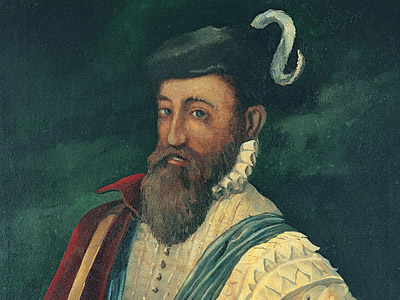Home | Main Menu | Castle Index | Historical Essays | Recommended Castles | What's New | Links
Sir John Perrot
 |

Home | Main Menu | Castle Index | Historical Essays | Recommended Castles | What's New | Links
 |

From the Cadw guidebook for Laugharne Castle John Perrot was born in November 1528, introduced to the Court in the autumn of 1549 and knighted within a week of achieving his majority in November of that year. He was a staunch Protestant during the reign of Queen Mary (1553-58), eventually deciding that it was wiser to leave the country and join a military expedition in France. Despite this, and after five years of lobbying, Mary granted Perrot the castle and lordship of Carew.
With Mary's death, Perrot's fortunes changed. He was favoured by Queen Elizabeth (1558-1603) and divided his time during the 1560s between the Court and Pembrokeshire, where he consolidated his power base. A man of somewhat fiery temperament, he had no difficulty in acquiring enemies both at Court and in south-west Wales.
Below: Perrot's magnificent north range at Carew Castle
In 1571 the queen appointed Perrot as the first lord of Munster. He returned in 1573, worn out from his experience but after what appears to have been two relatively successful years in Ireland. He then largely withdrew from public life spending much of the next ten years developing his estates in Pembrokeshire. In 1584 the queen appointed Perrot Lord Deputy of Ireland.
Below: Perrot's restyled castle at Laugharne
Perrot's time in Ireland as Lord Deputy, like that of those who had gone before and were to succeed him, was not an easy one. It is a measure of his ability that he was able to return in 1588 with his reputation, if not his health, intact. However, his absence had provided an opportunity for his enemies, both in Court and elsewhere, to conspire against him. In March 1591 he was imprisoned on the Tower. Found guilty on a charge of high treason, he was condemned to death on 27 April 1592. He died of ill health (although there is a suggestion that he may have been poisoned) on 3 November that teat before sentence could be carried out. There is some evidence that the queen may have been on the point of pardoning him.
From the official guidebook for Carew Castle
Good Sir John
Sir John Perrot was born in 1530 to Mary Berkely, wife of the prominent Pembrokeshire landowner and courtier Sir Thomas Perrot of Haroldston. But he was rumored to be the illegitimate son of Henry VIII, to whom he bore a strong resemblance.
He was a favourite at court during the reigns of Henry VIII and Edward VI but was briefly imprisoned by Mary Tudor for sheltering Protestant heretics, and spent much of her reign abroad. His fortunes revived when Elizabeth came to the throne in 1558, and he was one of the four bearers who carried her canopy of state at her coronation.
During Queen Elizabeth's reign he rose to particular prominence becoming Lord Deputy of Ireland in 1589. In Ireland he gained a reputation for brutality but came back a much wealthier man.
Flamboyant and ambitious, Perrot was noted for "majesty of personage" and dubbed "good Sir John". However, he seems to have had an unfortunate talent for making enemies. As Vice-Admiral of West Wales one of his duties was to stamp out piracy and smuggling along the coast. Local merchants complained that - far from fulfilling his duty - he was deeply implicated in contraband operations, and they petitioned the Crown for an investigation.
Perrot's worst mistake, however, was to make indiscreet remarks about the Queen. In 1591 he was arrested, tried and convicted of high treason. Elizabeth was reluctant to sign her supposed half-brother's death warrant or to pardon him. He was imprisoned in the Tower of London, where he solved Elizabeth's dilemma by dying of natural causes in 1592.
Visit the Carew castle page
Visit the Laugharne Castle page

Home | Main Menu | Castle Index | Historical Essays | Recommended Castles | What's New | Links
Copyright © 2009 by Jeffrey L. Thomas